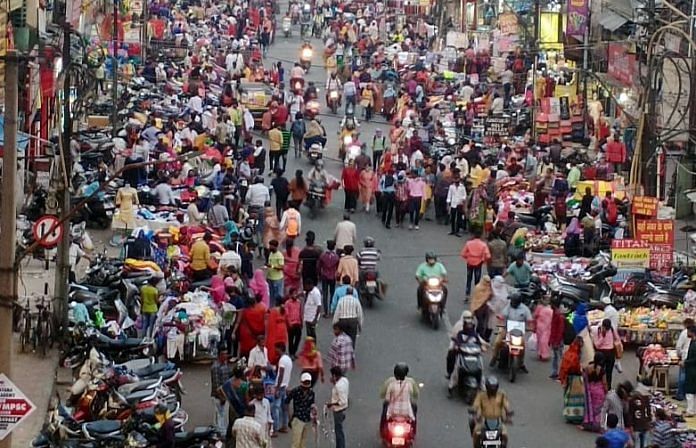New Delhi: India’s bent coronavirus curve has seen an unfortunate uptick in the recent weeks — India saw a 33 per cent increase in active coronavirus cases between 8 and 15 March, and a 28 per cent increase in Covid-19 deaths in the same period.
On 15 March, India reported 26,300 coronavirus cases, the highest in 85 days.
In episode 703 of ‘Cut the Clutter‘, Editor-in-Chief Shekhar Gupta looked at the data of India’s three problem states — Maharashtra, Kerala and Punjab to understand the mistakes we’re making that are leading to the rise in cases.
Maharashtra
Maharashtra comprises only seven to eight per cent of India’s population but 60-70 per cent of India’s caseload. Its cases per million are also much higher than the national average — the state has 18,800 cases per million while India’s average is 8,400 cases per million.
Between 11 February and 11 March, Maharashtra’s cases have increased from 37,000 to a little over 1,00,000. Across India, the test positivity rate is 1 per cent — Delhi’s test positivity rate is somewhere at 0.6 per cent, while Maharashtra is at 10 per cent, which shows you how bad the situation in the state really is, said Gupta.
According to Gupta, the biggest problem with Maharashtra remains the lack of adequate testing, “Maharashtra is testing less than Gujarat, It’s testing less than, believe it or not, Bihar, it’s testing at about the same level as Uttar Pradesh, which is inexplicable. And Maharashtra has done so since the very beginning. There is something about that government which tells you they’re averse to testing at a higher level,” said Gupta.
Maharashtra is also vaccinating too slowly. Today, it has 56 per cent of India’s active Covid-19 cases and is home to eight out of the 10 worst-affected districts but has only 7-8 per cent of India’s total vaccinations.
Quoting Dr. V.K. Paul, Covid-19 committee chief and NITI Aayog member, Gupta also said Maharashtra’s Covid-19 situation cannot be blamed on new variants because India, by now, has almost 7,000 variants of coronavirus, although there is a distinct variant that we see in Maharashtra, it is called E484Q, it is found in Vidarbha and is seen to be as contagious as the UK variant, added Gupta.
Also read: Delhi’s Covid situation in control as long as positivity rate is under 1% —Satyendar Jain
Punjab’s problems and lessons from Kerala
At 3.15 per cent, Punjab’s death rate due to Covid-19 is two and a half times the national average, while Kerala’s case fatality ratio is only 0.4 per cent.
“So, that means if 1,000 people fall sick in Kerala and Punjab, 35 will die in Punjab while only four will lose their lives in Kerala — that is the difference between the two states,” said Gupta.
Between 11 February and 11 March, Punjab’s Covid-19 cases have increased by 400 per cent. “Punjab has some issues like lots of comorbidities, carelessness, and people are coming to hospitals late for treatment,” Gupta said.
There are lessons to learn from Kerala. “Kerala has bent the curve in a positive direction over the last month — it has gone from 65,000 active cases to 36,000 active cases in that period,” explained Gupta, “Kerala’s rising cases were a serious cause of concern but in spite of the election campaign it has benefited with better discipline, more testing, etc,” he added.
Kerala has been testing quite aggressively. While the ballpark figure in India is 1,65,000 tests per million population, it is 3.6 lakh per million people for Kerala.
Kerala has the highest number of cases per million at 31,100. “But for 31,100, Kerala will have fewer deaths than Punjab will have for a case per million average of 6,600. The Punjab case per million is about one-fourth of Kerala’s, but Punjab’s fatality rate is almost nine times of Kerala,” said Gupta.
Slow vaccination drive
Coronavirus complacency has set in, evident in the mask-less crowd seen at the India-England T20 cricket match in Gujarat, said Gupta. People seem to have declared that the pandemic is over. All this while, the pace of India’s vaccine drive has not picked up.
“The Government of India needs to free up the vaccination process from this vaccination-quota Raj,” commented Gupta.
He said the vaccination process in India is going rather slowly. “You’ll see some propaganda and data going around that India has now vaccinated the second largest number of people in the world at about three crore. While that number is correct, put it in perspective — US has administered shots to 11 crore people, one-third of its population, while 2.6 crore in UK is half of its population. Three crore in India is just one and a half per cent of our population.”
India is lagging far behind. The US is administering 5 million jabs every day, while India is averaging 1.2 million. “At this rate, not only this wave but more Covid waves will come,” warned Gupta.
Watch the full episode here:
Also read: Night curfews don’t work, focus on tracing & vaccination, Modi govt tells Maharashtra



